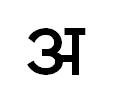Ṭa (Indic)
| Ṭa | Ṭha → | ||||
|---|---|---|---|---|---|
| Devanagari | Bengali | Gurmukhi | Gujarati | Oriya | |
| ਟ | ટ | ||||
| Tamil | Telugu | Kannada | Malayalam | Sinhala | |
| - | ట | ಟ | ഝ | ඣ | |
| Thai | Lao | Tibetan | Burmese | Khmer | |
| ฌ | - | ཛྷ | ဈ | ឈ | |
| Baybayin | Hanunoo | Buhid | Tagbanwa | Lontara | |
| - | - | - | - | - | |
| Balinese | Sundanese | Limbu | Tai Le | New Tai Lue | |
| ᬛ | - | ᤉ | - | - | |
| Lepcha | Saurashtra | Rejang | Javanese | Cham | |
| - | ꢚ | - | ꦛ | &#x; | |
| Tai Tham | Tai Viet | Kayah Li | Phags-pa | Siddhaṃ | |
| ᨫ | -- | - | - | ||
| Mahajani | Khojki | Khudabadi | Syloti | Meitei | |
| 𑅞 | - | 𑋄 | ꠏ | ꯓ | |
| Modi | Tirhuta | Kaithi | Sora | Grantha | |
| 𑘘 | 𑒗 | 𑂕 | - | 𑌝 | |
| Chakma | Sharada | Takri | Kharoshthi | Brahmi | |
| 𑄏 | 𑆙 | 𑚔 | - | ||
| Phonemic representation: | /ʈ/ | ||||
| IAST transliteration: | tta | ||||
| ISCII code point: | BB (187) | ||||
Tta is the eleventh consonant of Indic abugidas. In modern Indic scripts, ṭa is derived from the Brahmi letter ![]() after having gone through the Gupta letter
after having gone through the Gupta letter ![]() .
.
Āryabhaṭa numeration
Aryabhata used Devanagari letters for numbers, very similar to the Greek numerals, even after the invention of Indian numerals. The values of the different forms of ट are:[1]
- ट [ʈə] = 9 (९)
- टि [ʈɪ] = 900 (९००)
- टु [ʈʊ] = 90,000 (९० ०००)
- टृ [ʈri] = 9,000,000 (९० ०० ०००)
- टे [ʈe] = 9×1010 (९०१०)
- टै [ʈɛː] = 9×1012 (९०१२)
- टो [ʈoː] = 9×1014 (९०१४)
- टौ [ʈɔː] = 9×1016 (९०१६)
Devanagari script
| Devanāgarī |
|---|
 |
|
Diacritics, punctuation, symbols |
Ṭa (ट) is the eleventh consonant of the Devanagari abugida. In many languages, ट is pronounced as [ʈə] or [ʈ] when appropriate. In Marathi, ट is sometimes pronounced as [tə] or [t] in addition to [ʈə] or [ʈ]. [2] Letters that derive from it are the Gujarati letter ટ and the Modi letter 𑘘.
Bengali script
ট is used as a basic consonant character in all of the major Bengali script orthographies, including Bengali and Assamese.
Gujarati script
Ṭa (ટ) is the eleventh consonant of the Gujarati script. It is possibly derived from a variant of 16th century Devanagari letter ṭa (ट) with the top bar (shiro rekha) removed.
Thai script
To Patak (ฏ) is the fifteenth letter of the Thai script. It falls under the low class of Thai consonants. In IPA, to patak is pronounced as [t] at the beginning of a syllable and may not be used to close a syllable. The 21st letter of the alphabet, to tao (ต), is also named to and falls under the middle class of Thai consonants. Thai consonants do not form conjunct ligatures, and use the pinthu—an explicit virama with a dot shape—to indicate bare consonants. In the acrophony of the Thai script, patak (ปฏัก) means ‘skewers’. To Patak corresponds to the Sanskrit character ‘ट’.
Javanese script
References
- ↑ Ifrah, Georges (2000). The Universal History of Numbers. From Prehistory to the Invention of the Computer. New York: John Wiley & Sons. pp. 447–450. ISBN 0-471-39340-1.
- ↑ (Bahri 2004, p. (xiii))
Further reading
- Kurt Elfering: Die Mathematik des Aryabhata I. Text, Übersetzung aus dem Sanskrit und Kommentar. Wilhelm Fink Verlag, München, 1975, ISBN 3-7705-1326-6
- Georges Ifrah: The Universal History of Numbers. From Prehistory to the Invention of the Computer. John Wiley & Sons, New York, 2000, ISBN 0-471-39340-1.
- B. L. van der Waerden: Erwachende Wissenschaft. Ägyptische, babylonische und griechische Mathematik. Birkhäuser-Verlag, Basel Stuttgart, 1966, ISBN 3-7643-0399-9
- Fleet, J. F. (January 1911). "Aryabhata's System of Expressing Numbers". Journal of the Royal Asiatic Society of Great Britain and Ireland: 109–126. ISSN 0035-869X. JSTOR 25189823.
- Fleet, J. F. (1911). "Aryabhata's System of Expressing Numbers". The Journal of the Royal Asiatic Society of Great Britain and Ireland. Royal Asiatic Society of Great Britain and Ireland. 43: 109–126. doi:10.1017/S0035869X00040995. JSTOR 25189823.